Choosing the Right Curtains for Cream Walls
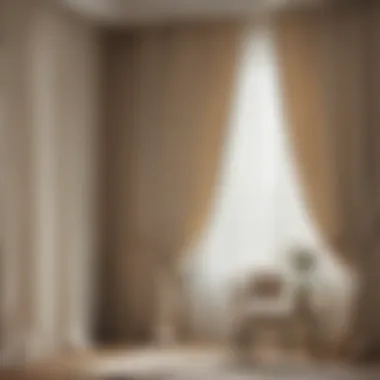
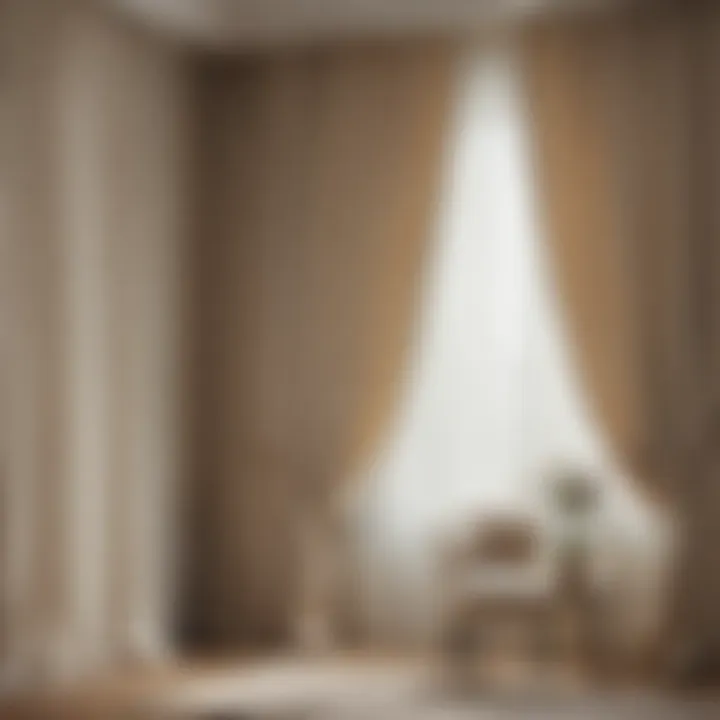
Intro
Choosing curtains for cream walls can be both exciting and challenging. Cream offers a warm base that pairs beautifully with a range of colors and textures. In this guide, we'll cover the art of selecting the right curtains to elevate your space. The balance between color theory and practical design will be our bread and butter as we navigate through various options. This is more than a straightforward task; it’s about creating a cohesive environment that mirrors your style and personality.
Key Insights and Trends
Current Trends in Interior Design
Understanding what’s hot in the world of interior design can give you a leg up on making your decisions. Many designers are leaning towards earthy tones and deeper shades that create a statement against the backdrop of lighter walls, including cream. For example, muted greens, rich burgundies, and navy blues are popular choices. These colors don’t just pop—they also bring about a sense of sophistication and warmth that complements cream beautifully.
Another trend is layering textures. L sheer curtains over heavier drapes or mixing fabrics like velvet and linen is a hot trend these days. This not only adds depth but caters to the functional aspects of light and privacy, which is key in today’s homes.
Popular Color Choices for Curtains
Selecting curtain colors involves understanding how they interact with light and with your walls. Some audience favorites include:
- Soft Grays: Neutral and elegant, soft gray curtains can add a sophisticated touch without overwhelming the space.
- Dusty Blues: These evoke calmness and go very well with the warm undertones of cream walls.
- Earthy Tones: Terracotta or olive green tones introduce a natural element that blends in beautifully with modern design.
Each of these colors not only harmonizes with cream but also aligns with a more holistic approach towards home interiors.
Practical Tips and How-To Guides
Step-by-Step Guides for Curtain Selection
When choosing curtains, consider the following steps:
- Assess Your Space: Look at existing furniture and decor. Are there colors that stand out?
- Determine Your Purpose: What do you want to achieve? Total blackout, a little light filtering, or a delicate diffusing effect?
- Sample Swatches: Always grab swatches. Curtains can look different in-store versus at home under natural light.
- Measure Twice, Cut Once: Measure your window and consider the height and width of the curtains. An elegant touch is to hang them higher to create the illusion of a taller room.
- Play With Patterns: Don't be afraid to mix patterns, but keep them in the same color family to maintain visual harmony.
Curtain Maintenance Tips
Keeping your curtains in tip-top condition goes a long way. Regularly cleaning and maintaining can prevent wear and tear:
- Vacuum Regularly: Use a soft brush attachment to keep dust at bay.
- Spot Clean Stains: Avoid a full wash if possible; keeping stains at bay is a better approach.
- Rotate Curtain Placement: Moving curtains around can help them wear evenly.
By following these insightful tips, your choice of curtains will not only amplify the beauty of your cream walls but also create a welcoming atmosphere in your living space.
"The right curtain can turn a simple space into a cozy haven, bringing out the beauty of your walls and decor."
With an understanding of trends, thoughtful selection steps, and maintenance tips, you can navigate the world of curtain choices confidently. As we move forward, you'll discover the perfect balance that complements natural light while enhancing your unique aesthetic.
Understanding Cream Walls
Cream walls can be more than just a backdrop; they set a mood and direction for an entire space. Understanding the interplay of this neutral hue in interior design is crucial for achieving a harmonious environment. When you choose to work with cream, you tap into a palette that whispers sophistication while maintaining an inviting warmth. These walls reflect light beautifully, often making a room feel larger and more airy.
Defining Cream in Interior Design
Cream is often seen as a softer version of white, offering a rich alternative to starkness. In interior design, cream offers versatility—easily pairing with a vast array of colors from vibrant shades to subdued tones. It’s often used in settings where a delicate balance between warmth and brightness is needed. Think of the understated elegance of a cream wall, which can serve as a blank canvas, ready to be brought to life with colorful art, furniture, or textiles.
Furthermore, cream can function as a neutral base in a variety of styles—be it rustic farmhouse or sleek modern. The defining characteristic of cream lies in its creamy undertones that can either lean warm or cool, depending on the specific shade chosen. This quality can shade the entire room's atmosphere based on how it interacts with other elements of decor.
The Emotional Impact of Cream Walls
Colors evoke feelings, and cream is no exception. It often conjures feelings of calm and relaxation, making it an ideal choice for bedrooms and living areas. Its soft, light-reflective quality creates a welcoming vibe, encouraging conversations and fostering connections. Using cream in your interior can make folks feel at home the moment they walk through the door. It creates that warming atmosphere, engaging in soft embraces rather than stark contrasts.
Moreover, cream walls can promote mindfulness and serenity—ideal attributes for spaces meant for unwinding. It’s a shade that resonates with peace and comfort, something we often seek in our hustle-and-bustle lives.
Common Misconceptions about Cream écor
There’s a common notion that cream is just bland or boring. Nothing could be farther from the truth. While it may not shout for attention like bold colors, cream serves a different role—it’s the silent hero of many design philosophies. It enhances other colors instead of competing with them.
Some people might think cream is too limited or that it can easily clash with other tones—this is another misconception. On the contrary, cream is versatile enough to work harmoniously with both warm and cool shades, enriching environments rather than detracting from them.
Additionally, some might assume that cream walls require constant upkeep due to potential discoloration. While they do show marks more readily than darker colors, modern technology in paints has yielded a variety of washable finishes that retain their charm while being practical.
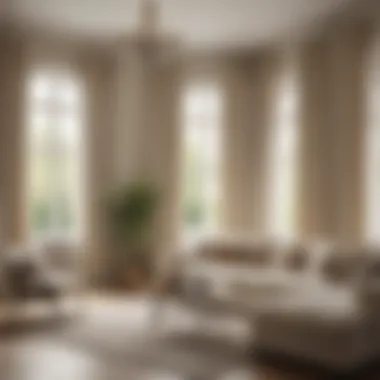

Color Theory Basics
Understanding color theory is not just a pigment of our imagination—it forms the backbone of a beautifully designed interior. In the context of selecting curtains for cream walls, color theory helps clarify how colors interact, evoke emotions, and ultimately affect the ambiance of a space. Homeowners and design enthusiasts often overlook the importance of this concept, mistakenly thinking that simply matching or contrasting colors is enough. However, a deeper delve into color theory can lead to a more intentional design choice, creating an aesthetically pleasing environment.
*
The Color Wheel Explained
The color wheel is a fundamental tool in the arsenal of design, serving as a graphical representation of colors organized in a circle. The wheel itself usually displays primary colors—red, blue, and yellow—that mix to create secondary colors like green, orange, and purple. This helps in visualizing relationships between different colors and can inspire rich combinations for your curtain choices. For cream walls, designers often lean heavily on this concept to establish color harmony in their spaces.
For instance, consider this: if you walk into a room enveloped in a warm, sunny cream, your eye is first drawn to it—scanning for colors that either complement or contrast effectively. Soft blues sitting adjacent to creamy yellows on the wheel can create a serene balance, while deep reds opposite the cream can offer a vibrant pop without overwhelming the senses.
"Using a color wheel is like having a map in a foreign land; it guides you through the vast array of choices to find harmony."
*
Warm vs Cool Colors
Colors can broadly be classified into two camps: warm and cool. Warm colors like reds, oranges, and yellows are inviting—perfect for spaces meant for social interaction, while cool colors include blues, greens, and purples, often evoking calmness. When choosing curtains for cream walls, the decision between these two categories can greatly influence the feel of the room.
For example, if your goal is to create a cozy reading nook, opt for warm tones like rust or goldenrod. These hues will enhance the inviting atmosphere created by the cream, making it feel like home. Conversely, for a more tranquil space such as a bedroom, soft cool colors like mint green or pale lavender curtains will contrast nicely with cream walls, promoting relaxation. Understanding this dynamic of warm and cool colors can steer your selection toward achieving the desired emotional resonance in your space.
*
The Role of Neutrals in Design
Neutrals serve as the ready mat in the world of colors, providing a foundation on which to build your design palette. Cream, by definition, falls into the neutral category, but it doesn't stop there. Shades like beige, taupe, gray, and soft whites can elevate a design when paired with the right curtains through texture and hue variations.
There’s an unspoken elegance in using neutral curtains against cream walls. It allows for other elements—like art, furniture, or decorative pieces—to take center stage. Soft white curtains can convey a sense of purity and simplicity, while taupe curtains can introduce a warm undertone, enriching the overall aesthetic.
Some design enthusiasts may think neutrals are boring, but in reality, they are essential for creating tranquil yet sophisticated spaces. By making mindful choices among these colors, you not only unify the decor but also bring a subtle richness to the room that invites exploration.
In summary, a thorough understanding of color theory enhances your ability to select ideal curtains for cream walls. It informs your choices about the wheel’s color relationships, the emotional temperature of warm and cool colors, and the functional role that neutral tones play in achieving a well-composed interior.
Choosing Curtain Colors for Cream Walls
Selecting the right curtain color for cream walls can seem like a small detail in a room's design, but it truly carries significant weight in achieving a harmonious and inviting space. Cream walls provide a soft backdrop that can take on different moods and styles, depending on the colors and patterns of the curtains you choose. The curtains serve as more than just functional elements; they’re vital in establishing a room's character.
By focusing on factors such as light reflectivity, the function of the room, and personal aesthetic preferences, homeowners can make informed decisions that elevate their interiors. The interplay between wall color and curtains is not merely aesthetic; it has psychological implications as well. Curious about finding a balance that feels just right for yourself and your guests? Delving into the harmony versus contrast debate helps clarify options amidst a spectrum of possibilities.
Harmony versus Contrast
One of the key aspects of choosing curtain colors lies in understanding the relationship between harmony and contrast. Harmony refers to how different colors work together in a way that feels cohesive and pleasing, while contrast introduces a vibrant dynamic that can make certain features of a design pop.
- Harmony can be achieved by selecting curtains in shades that closely align with the undertones of the cream walls. For instance, if the cream has warm undertones, curtains in soft yellows or warm beige can create a tranquil atmosphere that soothes the mind.
- Contrast, on the other hand, involves choosing bolder shades that significantly differ from cream. Think deep navy or rich burgundy, which can add depth and drama, breaking up the monotone look and drawing the eye.
Ultimately, the choice between harmony and contrast will vary based on the mood desired in the space. A living room may benefit from the serene vibe of harmonious colors, while a creative studio might call for lively contrast.
Color Combinations that Work
In the realm of curtain color combinations for cream walls, there is an impressive palette to explore. Here are a few noteworthy combinations:
Soft pastels
Soft pastels, such as blush pink, mint green, and pale lavender, lend an air of sophistication while still maintaining a soft feel that complements the neutrality of cream. These colors are not only gentle but also capable of reflecting light in a way that keeps a space feeling open and airy. The unique characteristic of soft pastels is their ability to evoke feelings of relaxation and calmness, making them a popular choice for bedrooms or nurseries. However, they may lack a certain boldness, which could be a drawback if one desires a more striking profile in their decor.
Bold jewel tones
Moving into bolder territory, jewel tones like emerald green, sapphire blue, and ruby red can create rich visual interest against cream backgrounds. The striking feature of these colors is their depth and vibrancy, which can uplift a space and make it feel more grounded and sophisticated. Such hues are particularly beneficial in larger rooms or spaces designed for entertaining, as they create a lively conversation starter. However, one must be cautious—overuse or poor pairing can lead to a chaotic aesthetic, jeopardizing the overall harmony of the room.
Earthy shades
Lastly, earthy shades such as terracotta, olive green, and muted mustard offer a natural connection to the environment that can enhance the coziness of a room. These colors are underscored by their organic essence, and their strength lies in their warmth. Earthy tones help create a grounding space that feels inviting, often complementing wooden elements or plants in the decor. One disadvantage, however, could be that if not balanced correctly, they might overshadow the light and airy feel typically associated with cream.
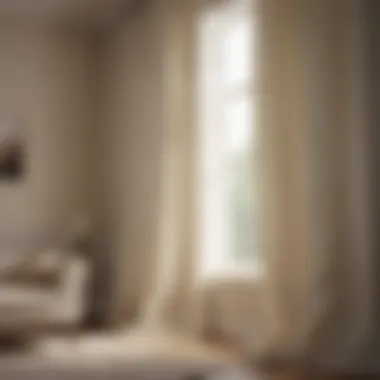

Each category of color combinations contributes its own advantages to a well-thought-out design approach. As you journey through color choices for your curtains, weigh these aspects carefully, and you'll discover the best fit for your space.
Practical Considerations in Curtain Selection
When choosing curtains for cream walls, it's essential to take a moment to ponder practical considerations. This aspect of interior design can significantly affect the overall impact of your space. Selection extends beyond mere color coordination; it also encompasses functionality, material, and upkeep. Homeowners and design enthusiasts need to weigh several factors carefully to ensure that their choices not only look appealing but also serve their intended purpose.
Room Functionality and Lighting
The first element to assess is how the room functions. Each space has its distinct atmosphere, which can be influenced heavily by the choice of curtains. For instance, in a cozy living room flooded with sunlight, sheer curtains can provide the right balance—allowing natural light to cascade in while offering some level of privacy. If the room doubles as a media space, blackout curtains may be necessary to keep light at bay.
Consider these points:
- Natural Light Needs: Does the room need bright light, or is it better suited for softer lighting?
- Purpose of the Room: A bedroom may benefit from curtains that promote restful sleep, whereas a kitchen may prioritize easy cleaning and versatility.
- Seasonal Changes: In winter, thicker fabrics may trap warmth while lighter materials might be favorable in summer.
By understanding the room's function and prevailing light conditions, homeowners can make choices that enhance utility and comfort.
Fabric Choices Impacting Color Perception
The fabric you choose for the curtains can create varying moods and perceptions of color. Textures also play a pivotal role in how colors interact with your cream walls. To illustrate, a satin fabric could provide a chic sheen that amplifies colors, thus enriching your chosen palette, while a matte fabric may subdue hues, lending itself to a more understated elegance.
Here are some fabric factors to contemplate:
- Luster: Shiny materials reflect light while matte ones absorb it. Consider how this will interact with the cream backdrop.
- Thickness and Insulation: Heavier fabrics may block out light and add warmth, which is important if maintaining a cozy atmosphere is a priority.
- Draping and Movement: Some fabrics have a lovely fluidity, creating appealing shapes when drawn or gathered, which can add visual interest to an otherwise plain wall.
A thoughtful approach to fabric choice can elevate not just the curtains but the entire aesthetic of a room.
Maintenance and Durability
Last but certainly not least, is the consideration of maintenance and long-term durability. Depending on the room's purpose and foot traffic, the curtains might suffer from wear and tear over time. Thus, opting for materials that can withstand both usage and cleaning demands is paramount.
Consider these maintenance tips:
- Washability: Are they machine washable, or do they require dry cleaning? This can determine how practical they are in a busy household.
- Color Fastness: If your curtains are exposed to sunlight, consider colors that won’t fade easily over time.
- Durability: Fabrics like polyester have a reputation for being robust, while silk may require more careful handling.
Being savvy about maintenance can not only save you time and money but also keep your space looking fresh and inviting over the long haul.
"A well-thought-out curtain choice melds aesthetic appeal with practicality, ensuring that the living space remains functional and visually engaging."
In summary, thinking through practical considerations when selecting curtains can make all the difference. Balancing room functionality with fabric choice and maintenance needs helps ensure that curtains are more than just decorative accents—it turns them into integral components of a cohesive home design.
Specific Color Recommendations for Curtains
Choosing the right color for your curtains isn't just a matter of preference; it plays a significant role in harmonizing the overall aesthetic of a room, especially when the walls are painted in a soft cream. The color of your curtains can either emphasize or diminish the warmth offered by cream tones. In this section, we will cover specific color choices, their importance, and how each option can uniquely contribute to your interior design goals.
Neutral Curtain Options
White and Off-white
White and off-white curtains stand out as a timeless option when paired with cream walls. Their primary role is to maintain a clean and airy feel, enhancing the brightness of your space. A key characteristic of this choice is its subtlety; it doesn't overpower the walls but creates an illusion of spaciousness.
However, it's worth considering that while white offers a sleek touch, off-white can add a touch of warmth, preventing the room from appearing too stark. Furthermore, these curtains are often easier to maintain, as any dust or grime is less visible. But there's a downside: if overexposed to sunlight, these curtains can sometimes become yellowed over time. Choosing high-quality fabric and proper care can mitigate this.
Beige and Taupe
Beige and taupe curtains present a tailored, sophisticated look. These colors blend effortlessly with cream walls, providing a seamless transition that can make a space feel cohesive. Beige, with its sandy tones, introduces an earthy element without swallowing the light, making it a popular choice for many homeowners.
What’s unique about taupe is its versatility; it can evoke warm or cool undertones based on the exact shade you select. The downside, though, is that beige and taupe can sometimes dial down energy levels in a room, making careful consideration of other decor elements necessary. Additionally, they can occasionally wash out when paired with certain other colors, so keep that in mind during your larger design planning.
Bold Options to Create a Statement
Deep Blue
Deep blue curtains offer a striking contrast to cream walls, infusing the room with depth and richness. The intensity of deep blue is a double-edged sword; it brings both drama and elegance, turning a simple area into a sophisticated retreat. This color stands out, drawing the eye and offering a focal point that can balance the softness of cream.
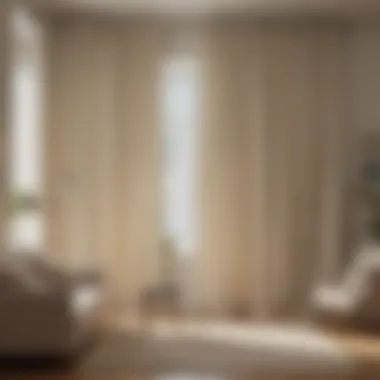

A key characteristic of deep blue is its ability to evoke tranquility while still making a bold statement. However, it's not all roses; using too much of this color could make a room feel small or surrounded, so placement and space considerations are critical. It may also limit your color options for accompanying decor.
Rich Emerald Green
Rich emerald green represents luxury and vitality. Pairing this shade with cream walls instantly revives and energizes a space. The vividness of emerald promotes a vibrant atmosphere that is both inviting and elegant, making it a favorite among design aficionados.
What makes emerald green truly unique is its wow factor; it stands out while maintaining an air of sophistication. This color can elevate other natural elements in a room such as wood or plants, enhancing the aesthetic. Still, a potential downside lies in its boldness — if not balanced with neutral or softer colors, it can become overwhelming and too loud, undermining its chic potential.
Soft Hues for a Gentle Touch
Blush Pink
Blush pink curtains add a soft, romantic touch to spaces with cream walls. They moderate the warmth of cream, injecting a bit of gentle color that creates a soothing environment. This choice is especially suitable for bedrooms or cozy sitting areas, where an inviting feel is paramount.
One of the key characteristics of blush pink is its ability to blend seamlessly with a variety of decor styles, from modern to vintage. Yet, it can sometimes risk looking too feminine or delicate if not paired correctly, potentially limiting the overall appeal of the space. Therefore, balancing it with bolder accessories or deeper colors is essential.
Sky Blue
Sky blue provides a fresh and tranquil atmosphere against cream walls. This hue draws inspiration from open skies, making it ideal for creating a relaxing space. Its soft, light nature complements the cream beautifully, enhancing feelings of airy openness.
The unique feature of sky blue is its calming effect; it's reminiscent of serene waters or clear skies, perfect for bedrooms or quiet reading nooks. While it offers many advantages, such as promoting peace and serenity, it could potentially make a large area feel too cold or washed out if not layered with rich textures or other complementary colors.
Textures and Patterns in Curtain Design
In the realm of interior design, the choice of curtains plays a pivotal role in orchestrating the overall aesthetics of a room. Specifically, when paired with cream walls, the textures and patterns of the curtains can either elevate or diminish the space’s appeal. It’s more than just picking a color; it’s about understanding how texture and pattern can influence the mood, depth, and character of a room.
Through the strategic use of texture, homeowners can integrate tangible elements into their design that add depth. For instance, a velvet curtain can imbue warmth and luxury, while a lightweight linen can evoke a breezy and casual feel. Patterns, on the other hand, serve as visual statements that can enliven a space. Choosing the right textures and patterns will not only provide a direct contrast but can also create a harmonious balance with cream walls, enriching the interior.
The Importance of Texture in Design
Textile texture is more than just a design decision; it affects how we perceive the space. The tactile quality of a curtain influences not only how it looks but also how it feels. For instance, incorporating a variety of textures can create an inviting atmosphere.
- Warmth: Fabrics like chenille or flannel can provide a cozy ambiance.
- Elegance: Silk brings a sophisticated finish, making the room feel upscale.
- Breeziness: Light cotton or sheer materials promote openness, ideal for brightening up a small room.
Textures also facilitate an interplay of light and shadow, shaping the overall energy of the space. A textured curtain can either soften harsh sunlight or play with natural light, creating a dynamic experience throughout the day. The curtains might catch the breeze and flutter delightfully, offering a different view depending on the angle from where you look.
When to Use Patterns
Patterns can be a game-changer in interior design, especially in enhancing the visual story of a room. But timing and placement matter so much. Here’s when and how to strategically use patterns in curtains:
- To Define a Space: Large patterns can help delineate areas, particularly in open-concept living spaces. For instance, using floral prints can section off a cozy nook within a larger room, giving it its own identity.
- To Add Interest to Solids: If the overall color scheme leans towards neutral tones, incorporating patterned curtains—think geometric designs or abstract motifs—can energize the environment, drawing the eye and adding depth without overwhelming the senses.
- In Harmony with Furniture: Patterns can harmonize beautifully with existing furniture or décor. If the furniture features bold colors, consider softer patterns to contrast effectively; if the furnishings are minimalist, a more prominent pattern on the curtains can act as the focal point.
- Layering for Complexity: When combining patterns, it’s essential to maintain balance. Consider layering a simple dotted or striped curtain with a more complex floral pattern; this creates an intriguing backdrop without clashing.
"Textures and patterns serve as the vital thread connecting diverse elements in interior design, transforming an ordinary room into a vibrant narrative of style."
Final Considerations for Curtain Selection
When it comes to selecting curtains for cream walls, the choices can feel overwhelming. Yet, it’s crucial to approach the final decision with a clear mind. Curtains are not just practical; they play a pivotal role in enhancing the overall aesthetic of a room. A wrong choice can disrupt the harmony of your space, while the right one can pull everything together. This section tackles the essential elements you should keep in mind as you finalize your selections.
Trial and Error in Design Choices
Sometimes, the best way to find the perfect curtain is through trial and error. Interior design is as much an art as it is a science. You might think you found the perfect fabric or color, but once you get it up on the rods, things can look quite different. For instance, a vibrant color that seemed stunning in the fabric store may overpower your space once hung against cream walls. To avoid costly mistakes, consider ordering samples before committing to a purchase.
- Bring home swatches. Test them in different lighting to see how they change shade throughout the day.
- Use a curtain rod in a neutral color to gauge how the fabrics interact with the cream.
- A little experimentation goes a long way. Don’t shy away from trying something unexpected—sometimes the most thrilling finds come from the most uncertain choices.
Personal Style and Aesthetic Preferences
Your home should reflect your own style, including your choice of curtains. Some might lean towards minimalism, choosing sheer curtains that allow light to filter gently while maintaining privacy. Others might find joy in bold patterns that act as conversation starters.
Assessing your personal taste is essential. Are you drawn to classic elegance, or do you prefer a more bohemian flair? Understanding your aesthetic inclination can guide your choices:
- Match with existing decor. If your furniture is modern, opt for sleek, geometric patterns.
- Consider layering. Combining sheer and opaque fabrics can offer versatility and depth to the design.
- Look for inspiration. Home décor platforms like Pinterest or Instagram can provide a wealth of ideas; follow hashtags like #InteriorDesign or #CurtainStyle.
Seeking Professional Advice
If the selection process becomes overwhelming or you’re unsure about what will suit your space best, don’t hesitate to seek professional advice. Interior designers have the expertise and experience to help narrow down options and offer guidance tailored to your specific needs. They can provide insights you might not have considered:
- Consult a specialist. A designer can help you understand how fabric choice impacts lighting and ambiance.
- Utilize color theory. Professionals can help you match curtains not only to your walls but also to your furniture and artwork.
- Optimize functionality. Need curtains that block out light? Professionals can direct you to the most effective options.
"Choose wisely for your surroundings to enhance both comfort and charm in your home."
Final considerations in curtain selection for cream walls involve thoughtful deliberation and an openness to explore. By blending trial and error with your unique preferences and professional insights, you can be confident in your final choice, ensuring it enriches your living space.



